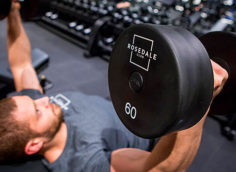Getting clients and athletes to use good form is one of the ongoing struggles of any trainer or strength coach.
You can tell your athletes to go all the way down on chin-ups until you're blue in the face. If you're lucky, you may get them to comply with your demands for a few reps, but the minute you turn your back, they'll inevitably start cheating in an effort to crank out more reps.
You'll see the same thing with squats and Bulgarian split squats. If you don't demand a full range of motion and stick to your guns – almost to the point of being a dick – you'll almost never see it. And even if you do demand it, you'll often see people start the set with good form and a full range of motion and then start to cut the reps short as pain and fatigue set in.
You'll also see people try to increase the weight too quickly and just start using a reduced range of motion and sloppier form. In fact, weight and form are often inversely proportional: the higher the weight, the worse the form.
The best way I've found to clean up poor technique is to use slower eccentrics. The eccentric phase of a rep is typically the lowering phase or the "negative." When you curl a barbell up, that's the concentric; when you lower it, that's the eccentric. With something like the chin-up, the eccentric is the part where you lower yourself down.
Slower eccentrics encourage using a full range of motion and also ensures that you're selecting a weight you can control. As an added bonus, slower eccentrics can be great for hypertrophy (muscle gain) and are often better tolerated by lifters with joint issues.
Some of the potential drawbacks of using slower eccentrics, however, are that sets can become painstakingly long and boring, you have to decrease the weight substantially, and they can leave you brutally sore. With that in mind, I use something called descending eccentrics.
The concept is simple. Pick how many reps you want to do for a given set – I recommend five reps for upper body exercises and six reps for lower body exercises. However many reps you choose, the eccentric phase of the first rep should last that many seconds and decrease by one second on each subsequent rep.
So let's say you're doing six reps. You'd do a six-second eccentric on the first rep, a five-second eccentric on the second rep, a four-second eccentric on the third rep, a three-second eccentric on the fourth rep, a two-second eccentric on the fifth rep, and a one-second eccentric on the final rep.
Because the earlier reps require slower eccentrics, it forces you to use a weight you can easily control and it encourages good form and full range of motion from the get-go. But because the eccentric phase gets progressively shorter, the set doesn't drag on endlessly and you're still able to use pretty heavy weight, and heavy weight with good form makes for one potent combination.
Descending eccentrics work great for chin-ups because it encourages a full range of motion and ensures that you're not using momentum or doing any of that kipping nonsense. Here's UFC heavyweight Brendan Scaub doing a set of five, which is much harder than you might guess:
It also works well for squats and front squats to establish full range of motion at the beginning of the set and ensure that you're not overshooting the weight.
This rationale also applies to Bulgarian split squats, but I've also found that slowing down the eccentric portion of the rep helps clean up the form in a hurry for clients who struggle with balance on unilateral lower body work. And for people who don't feel comfortable doing super heavy Bulgarian split squats for whatever reason, descending eccentrics are a way to get a good training effect with slightly lighter loads. Disclaimer: these burn!
These are just some examples, but you can apply the idea to virtually any exercise you want: bench press variations, glute-ham raises, push-ups, inverted rows, etc.
I wouldn't recommend using this technique for deadlift variations, free-weight rowing variations, and overhead pressing variations as I worry about putting undue stress on the lower back. But beyond that, use your imagination and get creative.





